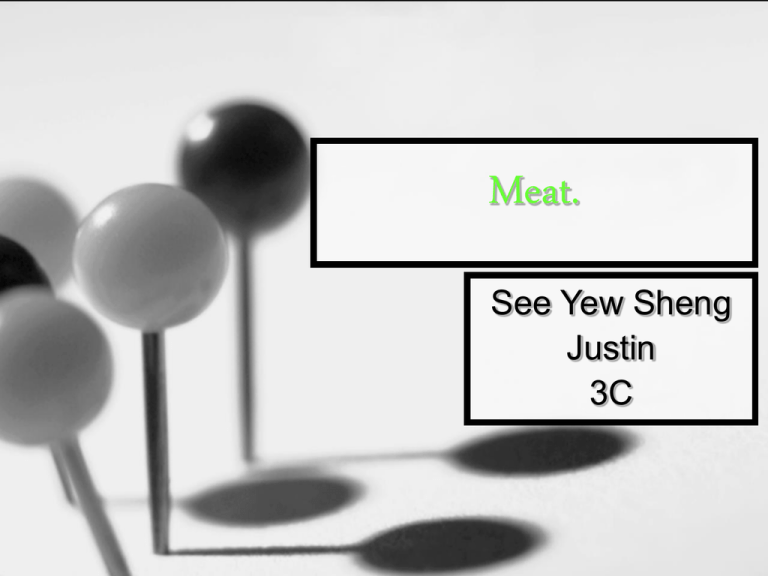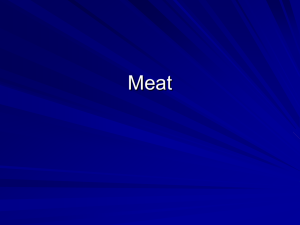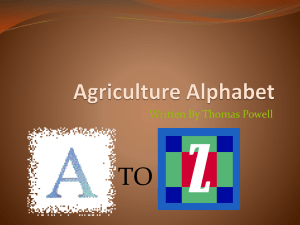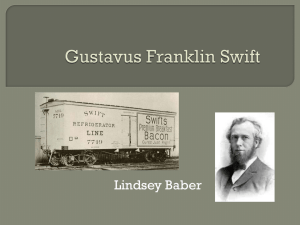Meat. - Food and Nutrition @ JVS
advertisement

Meat. See Yew Sheng Justin 3C Contents Page ;D Structure of Meat Types of Meat Examples of Offals Nutrients found in meat. Factors to consider when choosing meat Why is meat from young animals more tender than meat from old ones? (what makes meat tough or tender) Give and explain two other factors which contribute to the tenderness of meat ways to tenderize meat Reasons for cooking meat Effects of heat on meat Difference between meat and fish Ways to reduce fats when preparing meat for cooking. Structure Of Meat Meat composes of bundles of muscle fibres joined by strong connective tissues with fat scattered between. The main protein in muscles is myosin and actin Connective tissues contain the protein collagen and elastin Different types of Meat Beef:Cow,cattle Mutton: Goat, Sheep Pork: Pig Veal: Calf Venision: Deer Offals Edible internal organs of animals Eg:Brain,kidney,heart,liver,tripe,tong ue -Very good source of Iron and vitaminB12(liver and kidney) Vitamin A(Liver) Glycogen(Liver) Nutritive Value Protein:Myosin,globulin collagen(in connective tissue) Fats:particularly lamb,pork and beef give flavours.moisture and texture.Some fats are found between muscle fibre of lean parts of meat.This is known as marbling Vitamin: a good amount of B group vitamins Minerals:A good amount of iron and phosphorus Cholesterol Water-60% Factors to consider when choosing meat. Good characteristic colour No unpleasant smell Firm and elastic to touch,moist but not wet Grain should be fine and even Avoid too much bone,gristle or fat What makes meat tough or tender? Fat distributionWhen fat is even distributed throughout the muscle, the meat is usually more tender and of a better flavour than meat that has more visible deposits of fats. Meat is tender for young animals as muscle fibre are small and finer. As the animal matures, the muscle fibre thickens and there is more connective tissues. Thus, the meat from the older animal is tougher than the meat from young animals. There is also more fat in older animal. What makes meat tough or tender? The part of the animal and fat distribution. Meat from the leg is usually tougher than meat from the ribs because the leg muscles work harder, the more the animal works the muscle, the tougher it will be. When fat is evenly distributed throughtout the muscle, the meat is usually more tender and of a better flavour than meat that has more visible deposits of fats. Methods used to tenderize meat Mincing or grinding Cubing.Slicing Pounding with a meat pounder or the blunt edge of a cleaver Sprinking with commercial tenderizer e.g. papaya Marinating e.g. soya sauce,acids lemon juice,vinegar,tomato,yoghurt,wine Looking slowing with water e.g. stewing,boiling(Collagen in the connective tissue changes into gelatin which dissolves in the water and the meat come apart easily) Reason for cooking meat To kill any harmful bacteria To make it tender and more digestable To make it look,taste and smell more appetizing To preserve food for later use To develop extractives for flavour Effects of heat on meat Dry heat Protein starts to coagulates at 60degree Red meat changes to brown Fats melts and goes crisp making meat juicy Meat shrinks as protein coagulates and shortens Effects of heat on meat Moist Heat Protein starts to coagulates at 60degree when outer layer is sealed lightly Red meats changes to grayish brown Fat melts partly and seeps into the gravy Meat shrinks a little. The longer the duration of cooking ,the greater the shrinkage juices tend to come out of the meat into the gravy, developing a rich flavour in the gravy. with slight loss of flavour of meat. Collagen in connective tissue is converted to gelatin. Overcooking results in the meat falling apart. Moist heat method (boiling ,stewing, frying) is recommended for cooking tough meat as it is a slow process Meat is more difficult to digest than fish Fish has no elastin (elastin makes the wall of muscle fibre very tough and it cannot be changed by cooking, but elastin can be broken down mechanically or removed) Fish consists of short fine fibres bound together by a small amount of fine connective tissue. Ways to reduce fat content Use more poultry, reduce consumption of red meat Avoid frying, grill or bake instead Remove fat before cooking. ARTICLE:Eating Red Meat Raises Death Risk from Cancer and Other Diseases (NaturalNews) A diet high in red or processed meats significantly raises a person's risk of early death, particularly from cancer and heart disease, according to a study conducted by researchers from the U.S. National Cancer Institute and published in the Archives of Internal Medicine. "The need is for a major reduction in total meat intake, an even larger reduction in processed meat and other highly processed and salted animal source food products, and a reduction in total saturated fat," wrote Barry Popkin of the University of North Carolina-Chapel Hill, in an accompanying article. The researchers reviewed dietary and mortality data for more than 500,000 people over a 10-year time period. They found that those with the highest intake of red or processed meat had a significantly higher risk of death from all causes than those who ate the lowest amount. The greatest risk increase was seen for death from heart disease or cancer. Sources for this story include: news.bbc.co.uk. Credits: http://www.naturalnews.com/026692_m eat_risk_cancer.html Those who got most of their meat intake from white meats had a significantly lower risk of death than those who ate a higher proportion of red meat. People in the highest intake group ate an average of 160 grams (5.6 ounces) of red or processed meat per day, while those in the lowest intake group ate an average of 25 grams (0.88 ounces) per day. The researchers concluded that if everyone in the study had lowered their combined red and processed meat consumption to 25 grams per day, a full 11 percent of the deaths that took place among men and 16 percent of the deaths that took place among women could have been prevented. A growing number of studies are pointing to the conclusion that red and processed meats can have a significant effect on human lifespan. According to a recent survey, 10 percent of U.K. residents have tried to reduce their intake of such meats in response to these findings. Sources for this story include: news.bbc.co.uk. Credits: http://www.naturalnews.com/026692_m eat_risk_cancer.html Test List the nutrients found in meat. What are offals? Give two examples Why is meat from young animals more tender than meat from old ones? Give and explain two other factors which contribute to the tenderness of meat List three ways to tenderize meat Explain the difference between meat and fish Provide the factors to consider when choosing meat List ways to reduce fats when preparing meat for cooking. Answer scheme Protein,Fats,Vitamin,Minerals,Choles terol,Water Kidney,liver Young animals,muscle fibre are small and finer,meat is tender.As the animal matures,the muscle fibre thickens and there is more connective tissues.Thus,the meat from the older animal is tougher than the meat from young animals.There is also more fat in older animal The part of the animal and fat distribution. Meat from the leg is usually tougher than meat from the ribs because the leg muscles work harder, the more the animal works the muscle, the tougher it will be. When fat is evenly distributed throughtout the muscle, the meat is usually more tender and of a better flavour than meat that has more visible deposits of fats. Mincing or grinding, Cubing or slicing, pounding. -Meat is more difficult to digest than fish Fish has no elastin(the wall of musclefibre,very tought,cannot be changed by cooking but can be broken down mechanically or removed) Fish consists of short fine fibres,bound together by small amount of fine connective tissue -Good characteristic colour, No unpleasant smell,firm and elastic to touch,moist but not wet.Grain should be fine and even, avoid too much bone,gristle or fat -Use more poultry,reduce consumption of red meat.Avoid frying.grill or bake instead.Remove fat before cooking







